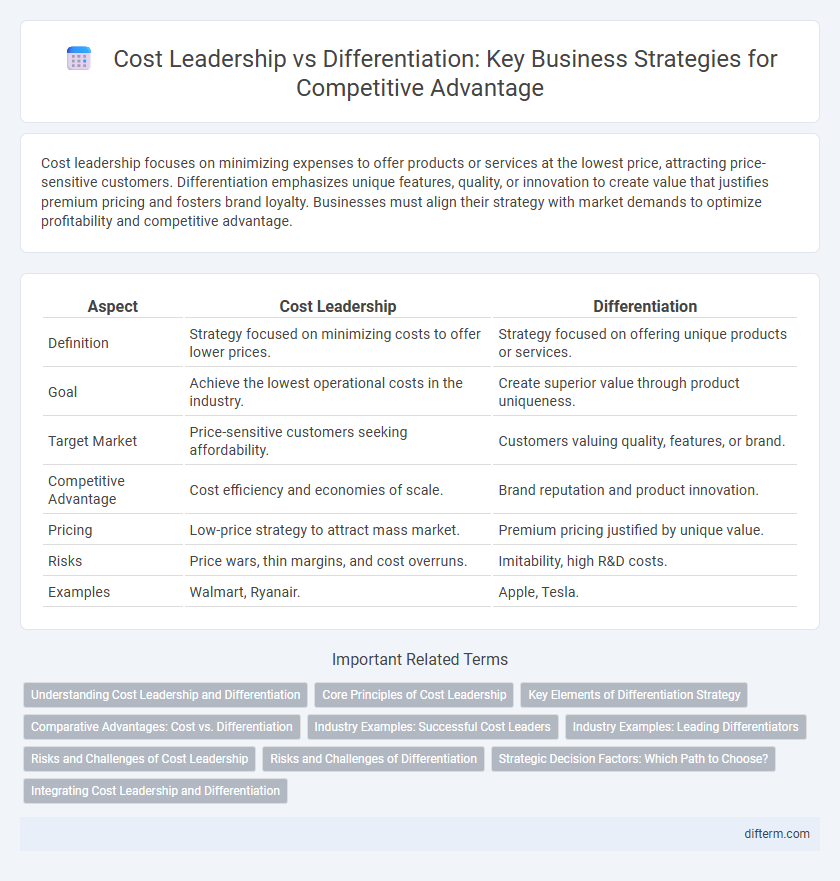Cost leadership focuses on minimizing expenses to offer products or services at the lowest price, attracting price-sensitive customers. Differentiation emphasizes unique features, quality, or innovation to create value that justifies premium pricing and fosters brand loyalty. Businesses must align their strategy with market demands to optimize profitability and competitive advantage.
Table of Comparison
| Aspect | Cost Leadership | Differentiation |
|---|---|---|
| Definition | Strategy focused on minimizing costs to offer lower prices. | Strategy focused on offering unique products or services. |
| Goal | Achieve the lowest operational costs in the industry. | Create superior value through product uniqueness. |
| Target Market | Price-sensitive customers seeking affordability. | Customers valuing quality, features, or brand. |
| Competitive Advantage | Cost efficiency and economies of scale. | Brand reputation and product innovation. |
| Pricing | Low-price strategy to attract mass market. | Premium pricing justified by unique value. |
| Risks | Price wars, thin margins, and cost overruns. | Imitability, high R&D costs. |
| Examples | Walmart, Ryanair. | Apple, Tesla. |
Understanding Cost Leadership and Differentiation
Cost leadership focuses on achieving the lowest production and operational costs to offer competitive pricing and attract price-sensitive customers. Differentiation emphasizes creating unique products or services with superior quality, features, or brand reputation to justify premium pricing and foster customer loyalty. Understanding these strategies enables businesses to position themselves effectively within their industry and maximize profitability.
Core Principles of Cost Leadership
Cost leadership centers on minimizing production and operational expenses to offer products or services at the lowest market price, enhancing competitive advantage. This strategy emphasizes economies of scale, efficient supply chain management, and rigorous cost control across all business functions. Companies implementing cost leadership prioritize standardized processes and high asset utilization to sustain profitability while maintaining lower prices.
Key Elements of Differentiation Strategy
Key elements of a differentiation strategy center on delivering unique product features, superior quality, and exceptional customer service that distinguish a company from its competitors. Investing in innovation, branding, and customer experience creates perceived value that commands premium pricing and fosters brand loyalty. Effective differentiation requires deep market research to understand customer needs and strategic resource allocation to maintain sustainable competitive advantage.
Comparative Advantages: Cost vs. Differentiation
Cost leadership strategies emphasize minimizing production and operational expenses to offer the lowest prices in the market, appealing primarily to price-sensitive customers. Differentiation strategies focus on creating unique products or services through innovation, quality, or branding, allowing businesses to command premium prices. Firms leveraging cost leadership gain competitive advantage through efficiency and scale, while those pursuing differentiation benefit from customer loyalty and reduced price competition.
Industry Examples: Successful Cost Leaders
Walmart exemplifies cost leadership by leveraging economies of scale and efficient supply chain management to offer low prices across retail markets. McDonald's achieves cost leadership through standardized operations and bulk purchasing, enabling affordable menu options globally. Toyota maintains cost leadership in automotive manufacturing by implementing lean production techniques that reduce waste and lower production costs.
Industry Examples: Leading Differentiators
Apple exemplifies leading differentiation through its innovative product design and ecosystem integration, commanding premium pricing in the technology industry. Tesla leverages advanced electric vehicle technology and brand prestige to differentiate in the automotive sector, attracting eco-conscious consumers. In the luxury fashion industry, Louis Vuitton maintains differentiation by emphasizing craftsmanship and exclusivity, enabling sustained competitive advantage.
Risks and Challenges of Cost Leadership
Cost leadership strategies face risks such as price wars, which can erode profit margins and threaten long-term sustainability. Maintaining low costs often requires significant operational efficiency, making the company vulnerable to supply chain disruptions and rising input prices. Limited product differentiation under cost leadership can reduce customer loyalty and increase susceptibility to competitor innovation.
Risks and Challenges of Differentiation
Differentiation strategies face risks such as high costs associated with innovation, marketing, and maintaining unique product features that may erode profit margins if not managed effectively. Market volatility and changing customer preferences can render unique attributes less valuable, leading to decreased brand loyalty and market share. Companies must also navigate the challenge of imitability, as competitors may replicate differentiated features, diminishing competitive advantage and increasing the need for continual innovation.
Strategic Decision Factors: Which Path to Choose?
Cost leadership focuses on minimizing production and operational expenses to offer competitive pricing, attracting price-sensitive customers while maintaining profitability. Differentiation emphasizes unique product features, superior quality, or exceptional service, enabling premium pricing and fostering brand loyalty. The strategic decision depends on market dynamics, competitive environment, and organizational capabilities, with firms assessing factors such as cost structure, customer preferences, and innovation potential to determine the optimal path.
Integrating Cost Leadership and Differentiation
Integrating cost leadership and differentiation strategies enables businesses to achieve competitive advantage by delivering unique value at lower costs. This hybrid approach leverages operational efficiencies alongside innovation and quality improvements to attract diverse market segments. Firms utilizing this integration enhance profitability and market resilience through cost-effective differentiation.
Cost Leadership vs Differentiation Infographic

 difterm.com
difterm.com